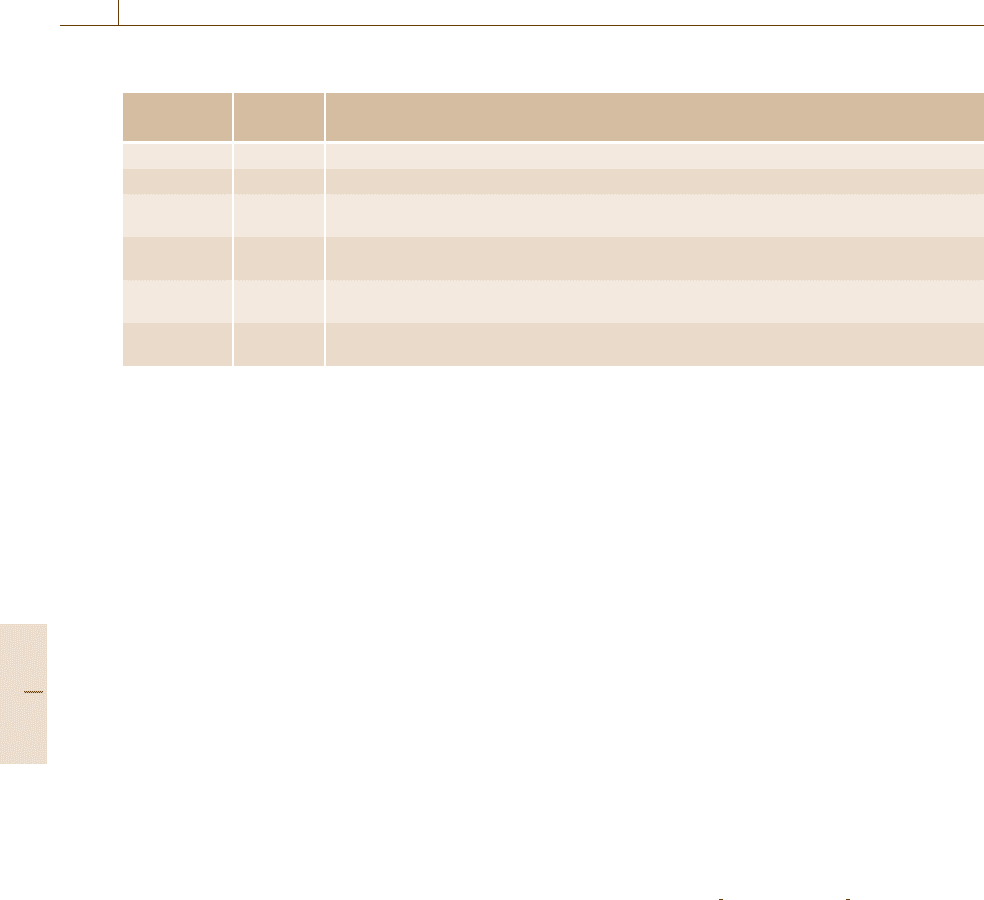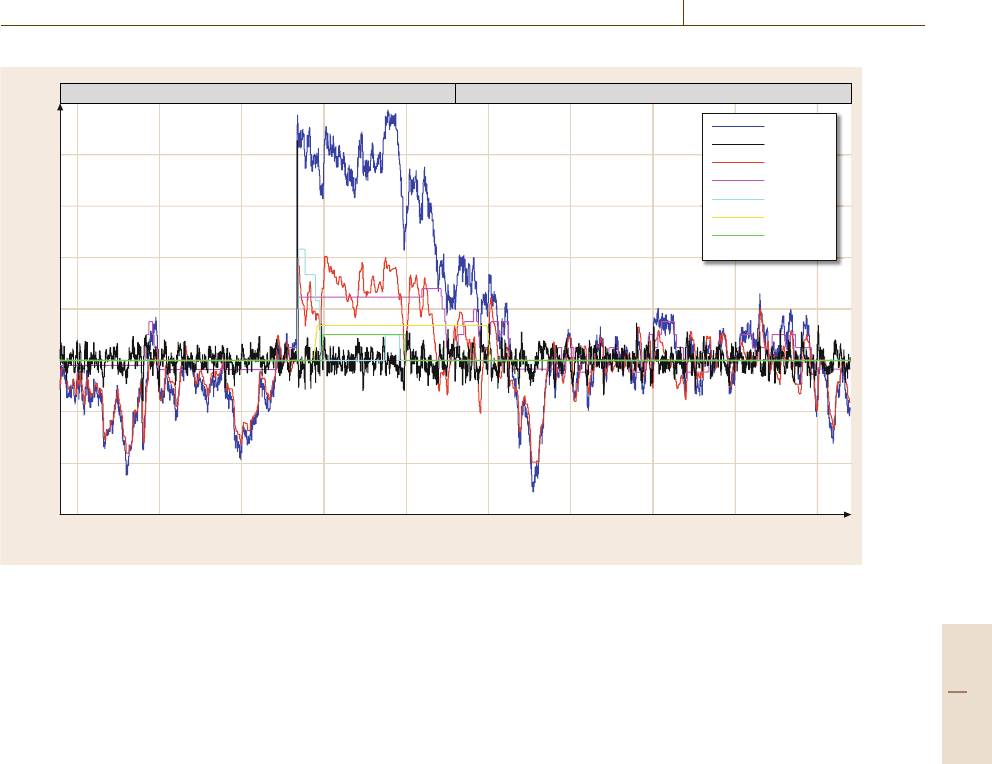Nof S.Y. Springer Handbook of Automation
Подождите немного. Документ загружается.


Securing Electrical Power System Operation 65.2 Ancillary Services Planning 1155
65.2.2 Minimal Needs of AS
In order to determine the power reserves in the form of
AS that would technically suffice for proper power bal-
ance control with acceptable reliability, it is necessary
to refer to reliability standards. Since the UCTE has no
specific reliability standards for its members [65.18],
seven indices describing reliability are defined in Ta-
ble 65.3 for this purpose. Each of them represents
a probability that ACE exceeds a certain threshold and
lasts for a certain amount of time (value at risk). The
index rACE
1
refers to the one-minute average value of
ACE, while theindexrACE
60
refers to an average value
of ACE over 1h.
The indices rACE
1
and rACE
60
are statistical mea-
sures of ACE that are related to NERC’s CPS2. rACE
1t
is linked to the UCTE requirement for frequency recov-
ery in less than 15min after a forced generation unit
outage, and thus it is similar to NERC’s DCS index. The
other indices (rACE
60 tx
) indicatethe possibledanger of
a longer-lasting powerimbalance that maylead toan ap-
plication of load-shedding mechanisms or to a blackout
in the worst case.
RZ
–
Σ min
RZ
+
Σ min
Not allowed Not allowed
1
(200 MW, 87 %)
0
100
Reserve Reserve
0
(%)
2
1
3
1Cumulative distribution function for ACE
OV
Acceptable range of ACE irrespective of number of cases
ACE
1
(MW)
Acceptable number of cases
when ACE
1
> limit
100–rACE
1
/2
rACE
1
/2
Acceptable number of cases
when ACE
1
≤ limit
Cumulative distribution function for ACE2
Area control error < 200 MW found in 87% of all observations (an example)
3
Fig. 65.9 Cumulative distribution function of the open-loop ACE and its use
The desired values were determined statistically
from historical recordsof ACE. A few consecutive years
should be evaluated.The durationof theperiod assigned
for statistical evaluation should correspond to a period
when the technical parameters of the transmission sys-
tem and the market conditions are compatible with the
current situation and practices. In addition, no prob-
lems related to the area performance should be reported
from either TSOs in adjacent areas or from domestic
customers. Hence, we can assume that the TSO’s per-
formance was satisfactory.
The indices are direct measures of the quality of
power balance control in the control area, and indi-
rect measures of the reliability of the power supply to
end-consumers.
The AS categories considered throughout the chap-
ter are described in Table 65.2. Analytical computations
of the minimal AS needs are based on the stochastic
characteristics of ACE and its components, as deter-
mined in Step 1. Regarding the fact that some of the
AS are mutually substitutable (i.e., faster-responding
services such as secondary control can be substituted
for slower-responding services such as tertiary control),
Part G 65.2

1156 Part G Infrastructure and Service Automation
Table 65.3 Reliability indices based on area control error time series evaluation
Performance Limit Description
index
value(%)
rACE
1
3.2 Probability that the absolute value of the one-minute average of ACE exceeds L
1
=100 MW
rACE
60
4.6 Probability that the absolute value of the one-hour average of ACE exceeds L
60
=20 MW
rACE
1t
0.027 Probability that the one-minute average of ACE is higher/lower than ±100MW for more than
15min
rACE
60t2
0.829 Probabilitythat the one-hour average of ACE is higher/lower than ±20MW within two consecutive
hours
rACE
60t3
0.140 Probability that the one-hour average of ACE is higher/lower than ±20MW within three consecu-
tive hours
rACE
60t4
0.040 Probability that the one-hour average of ACE is higher/lower than ±20MW within three consecu-
tive hours
the needs of the AS reserves are expressed in the form
of inequalities (65.14)–(65.18) rather than exact recom-
mended values for each AS category
RZSR
≥RZSR
min
, (65.14)
RZSR+RZTR
+
≥RZSR
min
+RZTR
+
min
, (65.15)
RZSR+RZQS+RZTR
+
≥RZ
+
(
min
, (65.16)
RZSR+RZTR
−
≥max
RZ
−
(
min
, RZSR
min
+RZTR
−
min
,
(65.17)
where RZ
+
(
min
≥ 0, RZ
−
(
min
≥ 0 are total mini-
mal volumes of positive and negative reserves, and
RZSR
min
≥0, RZTR
+
min
≥0 and RZTR
−
min
≥0 are the
minimal required volumes of the secondary, tertiary
positive and tertiary negative reserves, respectively. In
addition, (65.18) represents a UCTE N −1 criterion
RZSR+RZQS ≥C
N−1
, (65.18)
where C
N−1
is the installed power of the largest gener-
ator within the control area.
As the energy of the quick-start reserve is limited
and due to its quality in terms of a fast response after ac-
tivation, it should be preserved for future use asmuch as
possible. Thus, it is recommended that this fast service
should be replaced by a slower one whenever possible,
and the same amount of reserve should be planned for
such a slower service. This reasoning is expressed by
RZN
>30
=RZQS . (65.19)
Figure 65.9 illustrates how the total minimal vol-
umes RZ
+
(
min
≥ 0andRZ
−
(
min
≥ 0 are determined
from the cumulative distribution function of ACE
OV
.
According to thereliability standards, theabsolute value
of the closed-loop ACE is allowed to exceed the thresh-
old 100MW in rACE
1
% of cases. If this is split sym-
metrically into positive and negative values, an ACE
OV
that is higher than 100MW should be compensated
by the control reserves except in rACE
1
/2% of cases.
Hence, we need at least RZ
+
(
min
≥0andRZ
−
(
min
≥0
reserves to satisfy the standards of reliability derived
from area satisfactory performance in the past.
The secondary reserve RZSR
min
should compensate
for the fast variations of the open-loop ACE,andthe
tertiary reserve RZTR
+
min
, RZTR
−
min
should compensate
for the slow ACE variations.The minimal needs of these
services are determined in a similar manner to the to-
tal needs, but by utilizing the cumulative distribution
functions of ACE
OV slow
and ACE
OV fast
.
The values of the minimal AS requirements take
the form of a time series, which reflects the fact that
thebehavioroftheACE also varies; it is typically
more uncertain during transition periods with change-
able weather and temperature, such as during spring or
fall.
65.2.3 AS Bids from Generation Companies
Before calculating the costs of the optimal AS set, we
also need to know what energy and AS bids can be
expected on the market (Fig.65.7). The underlying as-
sumption is that under liberalized market conditions,
Part G 65.2

Securing Electrical Power System Operation 65.2 Ancillary Services Planning 1157
generation companies are only motivated by economic
factors, and their aim is to maximize their profit re-
gardless of transmission system needs and reliability
issues. A generation company decides how much of
its installed capacity will preferably be offered in the
form of energy sold to domestic retailers or abroad and
what amount will be offered to the TSO in the form of
AS. This part of the model solves a mixed integer lin-
ear programming problem involving unit commitment.
The main model inputs and outputs are summarized in
Table 65.4.
The model does not search for a demand-bid equi-
librium on the market, because the computational time
associated with a year-ahead simulation would be too
high. Hence, the expected AS and energy prices are
entered as the inputs. In other words, the model tells
the TSO the amount of AS reserves that are ex-
pected to be available on the market if their prices
are given. Thus, for instance, the TSO can enter the
maximum acceptable prices of AS and see whether
or not the bids meet the minimal AS needs in such
a case.
65.2.4 Procurement of Ancillary Services
The key point is to optimize the AS selection cover-
ing the minimal AS needs based on the lowest costs for
AS reservation. In the case where the minimal needs
of AS in a certain category determined in Step 2 are
higher than the offer on the market, the optimal pur-
chase algorithm takes this limited offer into account
by substituting the AS with a different AS category
if possible. The optimal purchase is stated as a linear
optimization problem
min
∀k
RZSR
k
RZTR
+
k
RZTR
−
k
RZQS
k
RZN
>30k
∀k
C
RZSR
k
RZSR
k
+C
RZTR
+
k
RZTR
+
k
+C
RZTR
−
k
RZTR
−
k
+C
RZQS
k
RZQS
k
+C
RZN
>30k
RZN
>30k
(65.20)
subject to the constraints (65.14)–(65.18). The index
k denotes individual AS providers, C
RZSR
k
, C
RZTR
+
k
,
C
RZTR
−
k
, C
RZQS
k
, C
RZN
>30k
are bid prices of the re-
spective AS, and RZSR
k
, RZTR
+
k
, RZTR
−
k
, RZQS
k
,
RZN
>30k
are the AS volumes purchased from the kth
AS provider.
Table 65.4 Main inputs and outputs of the AS market
model
Model inputs
1. List of power producers acting on the market and portfo-
lio of their generation units
2. Technical data for generating units (type of technology,
minimal and maximal outputs, certified AS ranges, etc.)
3. Economic characteristics of generating units (variable
costs, start-up and shut-down costs)
4. Planned unit outages
5. Domestic power consumption and foreign exchange
forecast
6. TSO’s expert estimate of future energy and AS prices
based on knowledge of the current market situation and
possible future trends
Model outputs
1. Time series of expected volumes of AS offered by each
of the AS providers in the market
65.2.5 Availability
of Self-Regulation Power
The transmission system is balanced by not only the
TSO but also the area generators. The generation
companies are economically motivated to meet their
contracted production. Thus, if one or more of their
units fail, the remaining capacity of the other units
is activated, if possible, to compensate for the forced
outage (self-regulation). However, this ability varies in
time and depends on instantaneous domestic consump-
tion, foreign exchange, etc. Therefore, an algorithm
for computing time-variable available capacity for self-
regulation is implemented and conducted as Step 5 in
Fig.65.7. In principle, the remaining available capacity
P
AC
can be determined as
P
AC
= P
IC
−P
OUT
−P
E
−P
AS
, (65.21)
where P
IC
is the installed capacity of generation com-
panies, P
OUT
are planned outages, P
E
is the sold energy
and P
AS
is sold AS. The self-regulation ability is then
taken into account in Monte Carlo simulations where
the forced generation unit outages are randomly gener-
ated.
65.2.6 Monte Carlo Simulation
of Power Balancing
The quality of the transmission system operation must
be validated for the intended ancillary services acquired
inStep4inFig.65.7 for several reasons. First, only two
of the performance indices rACE
1
and rACE
60
eval-
Part G 65.2

1158 Part G Infrastructure and Service Automation
uating the ACE time series were taken into account
when calculating technical needs of the AS. Second,
purchasing the AS may result in a different composition
of AS due to the limited offer from the AS providers.
To learn more about the behavior of the transmission
system, a power balancing control system simulator is
used to simulate the automatic activation of AS and to
mimic human operator interventions at the TSO control
center [65.19].
The logic used by the TSO operator manually ac-
tivating the respective categories of AS is modeled
as if-then rules. The operator evaluates past and pre-
dicted values of ACE, considers the balancing power
reserves left for immediate and near-future use and the
dynamics of the respective AS (i.e., the delay, ramp
up, ramp down), and checks the time taken for the ac-
tivation or deactivation of the AS to be realized. By
means of Monte Carlo simulations,this model generates
time series for open-loop ACE [65.19], AS activa-
tions/deactivations (both automatic and operator-based)
and, consequently, closed-loop ACE during a planning
period when using the recommended set of AS. Addi-
tional nonguaranteed types of AS,suchasemergency
assistance from abroad and the purchasing of balanc-
ing energy are also used in simulation runs. These types
of services are characterized by zero reservation costs
and limited availability (i.e., the services might be tem-
Reserved capacities: RZSR, RZTR
+
, RZTR
–
, RZQS, RZN30
+
RZSR
Man
Auto
Quick-start reserve
Tertiary reserve
Standby reserve
Emergency assistance from abroad
Dispatch rules
Energy management
Contingency management
Setpoints
for utilities
Response
dynamics
ACE
O
Open-loop ACE
without outages
ACE
OV
= Remaining ACE not compensated by the TSO = P
V
: Forced outages compensated by utilities; ΔP
EA
= Emergency assistance (from abroad)
P
C
Self-regulation capacity
P
VO
Forced outages
Balancing power
applied
Secondary controller
AGC
ACE
OV
predictor
P
VO
ΔP
QS
P
V
ΔP
TR
ΔP
DZ
ΔP
AE
ΔP
SR
ACE
OV
ACE
OV
ACE
Area generation
and load pool
ACE
Self-regulation
by
utilities
Fig. 65.10 Block diagram of a power balancing control system simulation for the area
porarily unavailable when required by the operator for
balance control). The availability of the nonguaranteed
types of AS is a parameter that can be set in the simula-
tor.
The master block diagram shown in Fig.65.10 gives
an overall picture of the simulator used in Step 6 in
Fig.65.7. The simulator is directly related to the feed-
back control scheme from Fig.65.3.
Simulated ACE
OV
, ACE with automatic activation
of the secondary reserve and manual activation of the
tertiary reserve, quick-start and standby reserves, emer-
gency assistance from abroad, and balancing energy
from abroad are shown in Fig.65.11. The simula-
tion shows a record for two days with a large power
deviation originating from an outage of a 1000MW
generator. The area control error not compensated by
the TSO ACE
OV
is the curve with the highest mag-
nitude. The producer compensates for the unintended
power deviation by activating its own power reserves.
As a result, ACE
OV
tends to be drawn towards zero but
the self-regulating action is not efficient enough and so
a significant power deviation remains for about 12 h,
which is unacceptable.
The situation improves when the TSO activates its
reserves. The secondary controller responds to the sud-
den increase in ACE almost immediately (red). As
the secondary power reserve available at that time
Part G 65.2

Securing Electrical Power System Operation 65.2 Ancillary Services Planning 1159
ACE
OV
ACE
SR
TR
QS
RZN
>30
Emergency
from abroad
25 30 35 40 45 50 55 60 65 70
Day n Day n +1
(MW)
(h)
1000
800
600
400
200
0
–200
–400
–600
Fig. 65.11 Activation of ancillary services for area power balancing
is about 400MW, it is not possible to cover the
massive outage solely using this reserve, and other
services must be called up to assist. The TSO’s op-
erator activates the quick-start reserve (cyan) and
the tertiary reserve (magenta) at the same time. The
pumped-storage quick-start must be saved as its ca-
pacity is limited, so the operator tends to replace it
as soon as possible with the services with a longer
response time, the standby reserve (yellow), and/or
tries to acquire services that are not guaranteed: emer-
gency assistance from the adjacent area (green). As
a result, the ACE (black) is minimized and the mas-
sive outage is well compensated for via a temporary
combination of ancillary services, or rather their ac-
tivation. The TSO’s manual intervention also assures
that the capacity of the secondary reserve is restored
as quickly as possible so the output of the auto-
matic load-frequency controller is driven away from
the limits, the power reserve purchased by the TSO in
advance.
65.2.7 Control Performance Evaluation
Although the AS needs were determined in Step 2 with
the aim of meeting the required reliability in terms of
the indices rACE
1
and rACE
60
, not all of the phe-
nomena influencing the reliability could be taken into
account inthe analyticalcomputations. For instance,the
dynamics of AS activation/deactivation and the limited
capacity of pumped-storage reservoirs are neglected.
Moreover, the AS set recommended for purchase is
often different from the minimal set due to limited of-
fers or the substitution of one AS for another. Hence,
through the statistical evaluation of the Monte Carlo-
simulated ACE, more realistic values of the reliability
indices rACE
1
and rACE
60
can be determined, and the
values of the other five indices introduced in Table 65.3
can also be found.
Other performance indices can be evaluated, includ-
ing NERC’s CPS2 and DSC, with the exception of
CPS1, as it requires the tie-line frequency deviation to
be simulated whereas the simulator [65.17] does not
support frequency.
65.2.8 Case Studies
Algorithms of AS planning and the area control system
simulator can be used for various studies and analyses
supporting TSO’s decision-making when planning and
purchasing ancillary services.
Technical and economic aspects are closely related
in this task, and it is essential to answer the question of
Part G 65.2

1160 Part G Infrastructure and Service Automation
how much it will cost to guarantee a commonly agreed
and accepted level of reliability in the system services
provided by the TSO. The methodology presented here
enables the relation between the reliability measured
through statistical evaluation of ACE and the cost of
purchasing the power reserves to be studied. A typical
relation between two reliability indices and the cost of
AS is shown in Fig.65.12.
The plot shows the relative increase or decrease in
the AS purchase cost when the request for reliability,
measured as the relative number of cases when minute
averages and hourly averages of ACE exceed specified
levels (e.g., 100MW for a minute and 20 MW for an
hour), is relaxed.
Several studies illustrating the capabilities of the
method can be found in [65.16], where the results of
year-ahead planning based on specifying the needs for
the individual services and the recommended optimal
purchase are shown. There can be significant differ-
ences between the needs and the purchase, which is
due to the fact that RZQS availability is limited to ex-
isting pumped-storage plants, and thus influenced by
their scheduled outages. A similar rule applies to the
standby reserve RZN
>30
. Thus, more positive reserves
must be acquired in the category of faster-response
AS purchase
cost change (%)
Acceptable
Not acceptable
Not acceptable
Low reliability
Acceptable
Standard: rACE
1
= 3,2%
rACE
60
= 4,6%
rACE
1
(%)
rACE
60
(%)
8.5
0
–8.5
–17
2
2
4
4.6
3.2
6
8
10
12
10
8
6
4
Nominal cost
Fig. 65.12 AS costs as a function of required reliability
services, according to (65.16). The expert-entered
prices of RZSR, RZTR
+
and RZTR
−
were related as
C
RZSR
> C
RZTR
+
+C
RZTR
−
, so the symmetrical RZSR
service is preferred to tertiary control, which results
in low or even zero purchasing of tertiary reserves
RZTR
−
. However, the volume of RZTR
+
is higher than
the needs during some periods of the year, as it substi-
tutes for the lack of RZQS andRZN
>30
in order to reach
the minimal positive reserve RZ
+
(
min
. A correlation be-
tween greater amounts of faster-response services and
improved reliability of power system operations can
also be observed.
Self-regulation of power producers is a risky fac-
tor. The level to which a generation company is willing
to eliminate the difference between the planned and
the actual production also depends on the penalty the
company will have to pay for the internal error. Stud-
ies carried out on the power balancing control system
simulator can be used to find out the acceptable rela-
tion for internal error charges. Reducing internal power
balancing reserves of the power producer will end up
increasing the cost of reserves that need to be acquired
for the entire area by the TSO. This cost will then be re-
lated to the reductionin the producer’s balancingpower.
Simulation studies in [65.16] show that a lack of self-
Part G 65.2

Securing Electrical Power System Operation 65.2 Ancillary Services Planning 1161
regulation capability in the utilities could increase the
TSO’s AS expenses significantly.
The methodology presented deals with the TSO’s
ancillary services planning and purchasing in order
to prevent undesirable situations in the transmission
system under changing market conditions and with pre-
dicting the influence of these changes on the TSO’s
expenditure. The AS planning method is shown for
year-ahead planning (including various analyses and
sensitivity tests, e.g., costs–reliability relation), and the
results provide support for the TSO’s strategies in the
annual AS auction. Despite the fact that the proposed
concept is tailored to the needs of a particular control
area in the UCTE interconnection, it represents a com-
pact approach to optimal AS planning.
The presented planning and modeling approach is
based on historical data. However, the method can in-
corporate the characteristics of new types of generation
units, study what installing wind turbines would mean
for ancillary services planning, and evaluate the cost of
reaching the same level of reliability.
Price elasticity can be incorporated into the model
of energy and AS bids in order to make the entire model
more realistic. The costs for AS will then supposedly
increase if the (optimal) volumes required in a certain
AS category are higher than usual.
The challenging task is todetermine the value of un-
served energy in the area. The value of unserved energy
is the loss to the economy if a MWh of the energy re-
quired by consumers cannot be supplied. Consequently,
the described methodology allows the optimal balance
between the costs of AS and the costs of unserved en-
ergy to be found.
65.2.9 Related Topics
Generation from Renewable Resources
Energy sources are undergoing permanent restructur-
ing. Large-scale renewable resource installations like
wind power, which is the world’s fastest-growing en-
ergy technology, represent a new challenge to the power
system. The fluctuating nature of wind power affects
power system reliability, deviating from the planned
powergeneration, whichleads to power balancing prob-
lems. Selecting appropriate approaches for calculating
the wind power-induced balancing power reserve while
respecting the specificity of regulatory and market sit-
uations in the region is currently an issue [65.20, 21].
Several detailed technical investigations of the impacts
of wind power plants on grid ancillary services needs
have recently been performed [65.22]. Although the
approaches vary, three utility timeframes appear to be
the most significant issues: regulation, load following
and unit commitment. This article describes and com-
pares the analytic frameworks from recent analysis and
discusses the implications and cost estimates of wind
integration. The findings of these studies indicate that
relatively large-scale wind generation will have an im-
pact on power system operation and costs, but that these
impacts and costs are relatively low at the penetration
rates that are expected over the next few years.
Transmission Congestion Management
Grid management has become notably more complex
over the past few decades. The level of grid usage is
increasing markedly in every region. Consistently high
utilization of critical assets in a network often means
that these assets become bottlenecks that limit the use
of the network and its ability to serve demands at ev-
ery level consistently and reliably. These points on the
grid create transmission constraints. In some cases they
create congestion by limiting the buyers’ ability to se-
cure energy from the most economical source, meaning
that energy must be purchased from closer, more costly
generators. In other cases, transmission constraints can
cause a reliability problem when customer demands ex-
ceed the delivery capabilities of the transmissionsystem
plus local generation.
As the power flows over a grid with rapidly chang-
ing electrical topologies increase, the local utility is no
longer able to see and manage every factor affecting
the flows through its share of the transmission grid.
The scope of grid monitoring and control that worked
effectively in thedays of highcapacity margins and lim-
ited interutility flows are no longer sufficient. Higher
grid usage causes greater reliability challenges, and
policy-makersand utilities then come to the opinion that
increasing the sizes of grid oversight and control orga-
nizations is the only effective way of dealing with these
challenges.
This problem is of great importance in coun-
tries/areas where, besides energy and ancillary services,
transmission capacity is a commodity in a deregulated
market for electricity and/or where the transmission ca-
pacities are almost/temporarily saturated (as is the case
when the transmission systems were not designed for
the power flows required).
The problems of ancillary services planning and
real-time balancing power reserve activation discussed
in this chapter do not address one important issue: the
limited capacity of the transmission lines. It can hap-
pen that the called-up ancillary service will overload
Part G 65.2

1162 Part G Infrastructure and Service Automation
a particular transmission line when there is a sched-
uled energy exchange. As the approach described so
far models the control area as a pool, it does not al-
low the control area network topology to be taken into
consideration. Other approaches must be applied.
Reference [65.23] presents major congestion man-
agement methods in the new market environment from
the international technical literature, which are pre-
sented and classified according to security-constrained
generation redispatch, zonal/cluster based management,
a network sensitivity factor-based method, congestion
management using FACTS devices, congestion pricing
and market-based methods, congestionmanagement us-
ing demand-side resources, and financial transmission
rights.
In a restructured power system, the transmission
networkis thekey mechanism forgenerators to compete
in supplying large users and distribution companies.
The role of the competitive electricity markets is de-
scribed in [65.24]. The lessons learned by ERCOT
(Texas ISO) in relation to flow-based zonal redis-
patch to relieve transmission congestion are discussed
in [65.25].
Further Reading
The electrical power industry has undergone dramatic
changes in many countries in recent years. Recent
deregulation has transformed it from a technology-
driven industry into one driven by public policy
requirements and the open-access market. Now, just
as the utility companies must change to ensure their
survival, engineers and other professionals in the in-
dustry must acquire new skills, adopt new attitudes,
and accommodate other disciplines. The book by
Denny and Dismukes [65.26] provides engineers with
a broad overview of most of the topics that should
be explored in order to understand and meet the chal-
lenges of the new competitive environment. Integrating
the business and technical aspects of the restruc-
tured power industry, it explains how new methods of
power systems operation and energy marketing relate
to public policy, regulation, economics, and engineer-
ing science. The authors examine the technologies and
techniques currently in use and lay the groundwork
for the coming era of unbundling, open access, power
marketing, self-generation, and regional transmission
operations.
References
65.1 L. Philipson, H.L. Willis: Understanding Electric
Utilities and De-regulation (CRC, Boca Raton 2005)
65.2 A. Orths, A. Schmitt, Z.A. Styczynsky, J. Verstege:
Multi-criteria optimization methods for planning
and operation of electrical energy systems, Electr.
Eng. 83, 251–258 (2001)
65.3 M. Ventosa, Á. Baíllo, A. Ramos, M. Rivier: Elec-
tricity market modeling trends, Energy Policy 33,
897–913 (2005)
65.4 L. Zuyi, M. Shahidehpour: Security-constrained
unit commitment for simultaneous clearing of en-
ergy and ancillary services markets, IEEE Trans.
Power Syst. 20(2), 1079–1088 (2005)
65.5 W.Tong,M.Rothleder,Z.Alaywan,A.D.Papalex-
opoulos: Pricing energy and ancillary services in
integrated market systems by an optimal power
flow, IEEE Trans. Power Syst. 19(1), 339–347 (2004)
65.6 UCTE: UCTE Operation Handbook (Union for the Co-
ordination of Transmission of Electricity, Brussels
2004), v2.2/20.07.04
65.7 I. Boldea: The Electric Generators Handbook: Syn-
chronous Generators (CRC, Boca Raton 2006)
65.8 M.B. Zammit, D.J. Hill, R.J. Kaye: Designing an-
cillary services markets for power system security,
IEEE Trans. Power Syst. 15(2), 675–680 (2000)
65.9 G. Chicco, G. Gross: Competitive acquisition of pri-
oritizable capacity-based ancillary services, IEEE
Trans. Power Syst. 19(1), 569–576 (2004)
65.10 Y.A. Liu, Z. Alaywan, M. Rothleder, S. Liu, M.A. As-
sadian: A rational buyer’s algorithm used for
ancillary service procurement, Proc. IEEE Power
Eng. Soc. Winter Meet. (2000) pp. 855–860
65.11 AERC: Reliability Standards for the Bulk Electric Sys-
tems of North America (North American Electric
Reliability Corporation, Princeton 2008)
65.12 G. Gross, J.W. Lee: Analysis of load frequency con-
trol performance assessment criteria, IEEE Trans.
Power Syst. 16(3), 520–531 (2001)
65.13 N. Jaleeli, L.S. VanSlyck: NERC’s new control per-
formance standards, IEEE Trans. Power Syst. 14(3),
1092–1096 (1999)
65.14 N. Jaleeli, L.S. VanSlyck: Discussion of analysis of
load frequency control performance assessment
criteria, IEEE Trans. Power Syst. 17(2), 530–531 (2002)
65.15 B. Stojkovic: An efficient approach for the load-
frequency control and its role under the conditions
of deregulated environment, Eur. Trans. Electr.
Power 16,423–435(2006)
65.16 P. Havel, P. Horacek, V.
ˇ
Cern
´
y, J. Fantík: Optimal
planning of ancillary services for reliable power
balance control, IEEE Trans. Power Syst. 23(3), 1375–
1382 (2008)
65.17
E. Jane
ˇ
cek, V.
ˇ
Cern
´
y, A. Fialová, J. Fantík: A new
approach to modelling of electricity transmission
system operation, Proc. IEEE PES Power Syst. Conf.
Expo., Atlanta (2006) pp. 1429–1434
Part G 65

Securing Electrical Power System Operation References 1163
65.18 L. Dale, D. Milborrow, R. Slark, G. Strbac: Total
cost estimates for large-scale wind scenarios in UK,
Energy Policy 32(17), 1949–1956 (2004)
65.19 P. Havel, P. Horacek, J. Fantík, E. Jane
ˇ
cek: Criteria
for evaluation of power balance control perfor-
mance in UCTE transmission grid, Proc. 17th IFAC
World Congr., Seoul (2008)
65.20 V.
ˇ
Cern
´
y, P. Jane
ˇ
cek, A. Fialová, J. Fantík: Monte-
Carlo simulation of electricity transmission system
operation, Proc. 17th IFAC World Congr., Seoul
(2008)
65.21 C. Ensslin: The influence of modelling accuracy on
the determination of wind power capacity effects
and balancing needs. In: Renewable Energies and
Energy Efficiency, Vol. 1, ed. by J. Schmid (Kassel
Univ. Press, Kassel 2007)
65.22 B. Parsons, M. Milligan, B. Zavadil, D. Brooks,
B. Kirby, K. Dragoon, J. Caldwell: Grid impacts of
wind power: a summary of recent studies in the
United States, Wind Energy 7(2), 87–108 (2004)
65.23 L.A. Tuan, K. Bhattacharya, J. Daalder: A review on
congestion management methods in deregulated
electricity markets, Proc. Power Energy Syst. (Acta
2004)
65.24 L.L. Lai: Power System Restructuring and Dereg-
ulation: Trading, Performance and Information
Technology (Wiley, New York 2001)
65.25 J.M. Griffin, S.L. Puller: Electricity Deregulation:
Choices and Challenges (Univ. Chicago Press,
Chicago 2005)
65.26 F.I. Denny, D.E. Dismukes: Power Systems Opera-
tions and Electricity Markets (CRC, Boca Raton 2002)
Part G 65
“This page left intentionally blank.”
